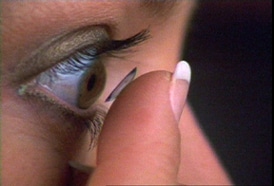Keratoconus is an eye condition that causes the cornea to become progressively thinner. A normal cornea is round or spherical in shape, but with keratoconus the cornea bulges forward, assuming more of a cone shape. As light enters the cone shaped cornea it is bent and distorted and unable to come to a point of clear focus on the light-sensitive retina.
Keratoconus usually affects both eyes but the two eyes often progress at different rates. This disease typically begins during teenage years. In most patients, it progresses for several years before stabilizing in the third to fourth decade of life. In severe cases it can continue to worsen. In these cases the cornea continues to thin and bulge outward, further blurring vision. Scarring of the cornea can also develop.
Symptoms of keratoconus:
- bulging, cone-shaped cornea
- nearsightedness
- astigmatism
- glare and light sensitivity
- the need for frequent prescription changes
Who is at risk:
Researchers believe that approximately 3 million people worldwide have keratoconus. It affects males and females of all races throughout the world. The causes are still being researched, but the likelihood of developing keratoconus is greater if you:
- have a relative with keratoconus
- have had excessive laser eye surgery
- have hay fever, eczema, asthma or food allergies
Treatment
In most cases of keratoconus, a patient will require both contact lenses or spectacles for vision and a procedure to treat the underlying disease.
Gas permeable (GP) or Scleral Contact Lenses
This is the primary treatment for keratoconus to improve the vision, particularly if spectacles are unable to correct the vision fully. To counteract the distortion of the cornea, most keratoconus patients require special hard lenses that help mold the corneal surface so that light can be focused clearly.

Because the pattern of distortion in keratoconus is as unique as a fingerprint, the contact lenses are custom prescribed and manufactured for each person’s eye.
A proper contact lens fitting is crucial to ensure optimal vision, comfort, and eye health. Poor fitting lenses can lead to corneal abrasions, scarring, and infection.
Corneal Cross-Linking
This is the newest treatment for keratoconus that has reduced the number of people that will need surgery for the condition. Keratoconus is a progressive disease that results in thinning and weakening of the cornea. Corneal Cross-Linking is a procedure that employs the use of Vitamin B2 (Riboflavin) and a special light to strengthen the cornea to try and prevent thinning. It is important to note that the purpose of Corneal Cross-Linking is not to improve the vision, but instead to stop the progression of the disease. This FDA approved treatment takes approximately 70 minutes to complete in office. You do not need any anesthesia for this procedure, and it is not painful, although you may experience some mild discomfort and light sensitivity in the days following the procedure while your eye is healing. Your doctor will determine if you are a good candidate for this procedure.
Surgery
Many keratoconus patients will never require surgery, but it is an option in severe and advanced cases. If your doctor determines you have significant warping or scarring of the cornea, he or she may recommend that you see the specialists at Omni Eye Services for a corneal transplant evaluation. In this procedure, the scarred tissue is replaced with a section of donated cornea that is clear. About 10 to 20% of keratoconus patients will eventually require a corneal transplantation. However, corneal transplantation is not a cure in and of itself. Following a successful corneal transplant, most patients still need glasses, soft contacts, or specialty contact lenses for adequate vision.
Precautions
Patients with keratoconus must not have LASIK or PRK laser eye surgery due to an unacceptable risk of a poor outcome. The cornea in keratoconus is unusually thin and weak. For patients with keratoconus, LASIK surgery thins and weakens their corneas further. This can irreversibly destabilize the cornea and accelerate its distortion. Rubbing the eyes may also increase the progression of keratoconus. Eye rubbing can often be very vigorous with patients using excessive force with their knuckles. Corneas already weakened by inflammation may develop thinning and protrusion as a result of rubbing.
For More Information
Your eye doctor is the best resource for specific questions about your diagnosis and treatment. Remember that regular eye examinations are crucial for preserving your eye health and vision.

